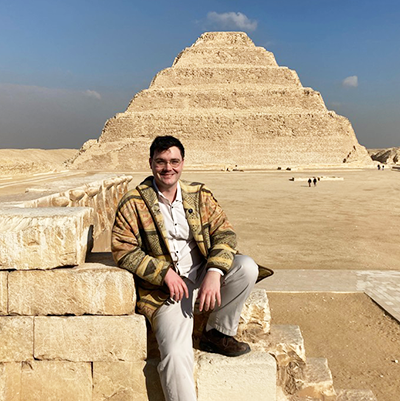FIMS News
Contact Information
FIMS Communications
Becky Blue
Email
519-661-2111x88493
FIMS & Nursing Building
Rm 2060C
John Kausch: Redefining Language One Software at a Time

By Debbie Duroshola
John's hometown: Ann Arbor, Michigan
Though the communication in today's society has advanced far enough to leave hieroglyphs in the past alongside the Egyptian pyramids, John envisions a future where a universal language is just a few systems out of reach.
---
In an increasingly digital world, John hopes to bridge the gap between creativity and engineering to create a global machine language for the categorization of knowledge.
John’s vision of creating a global machine language to sort through and classify knowledge is not far-fetched. In fact, it aligns with the Semantic Web’s goal of improving the efficiency of information processing on the Web, thus enabling John’s vision to become a reality.
“I'm passionate about the Semantic Web, a form of information technology that is meant to help us go into a more data driven world,” John says.
He explains that the Semantic Web represents a massive body of information that is presented in a format that is easily interpreted by machines. Current computer coding standards give machines limited information about the type of data they are handling. Through the Semantic Web, these machines are better able analyze and interpret the value of the data they are processing and sorting at an efficient rate.
Fun Fact
John loves exploring ancient ruins and his two favourite pyramids are the Pyramid of Unas in Saqqara, Egypt, and the Pyramid of Sneferu, located south of Cairo.
This innovative tool, if more widely adopted, paves the way for a more connected and advanced Web where knowledge can be shared and used in groundbreaking ways. To John, the Semantic Web could usher in a new era of language and communication, where technology can fundamentally expand the way people share and cultivate information.
According to John, such a shift would also help make artificial intelligence more exact by teaching AIs logic and reasoning. At its core, the Semantic Web is a data format for structuring information which helps machines be more logical. One day, it will be capable of providing people with a more organized and refined list of search results that is better tailored to their specific interests.
Driven by his passion for linguistics, John is committed to harnessing the potential of the Semantic Web through his research to revolutionize the way society works and communicates.
His current research involves working on designing a font of icons that can symbolize a list of universal ideas across languages. His design process is rooted in his prior work where he played a role in building a comprehensive database of words from various languages. With the lessons learned from this previous study, John intends to construct a user interface that incorporates his experiences in the field.
My past research went from studying how languages work in terms of their grammar, to looking at the underlying logic of language. Then I started to study the logical structures underneath language, which look like family trees, John explains. Studying these family trees led me to study ways to visualize the information underneath language for my master's degree. It started with language but moved to visualizing how we think.
While his previous field research has shaped and influenced his current studies, John credits the support and involvement of his peers for enriching his present-day research with their fresh perspectives and innovative ideas.
FIMS is a lovely intellectual community that's highly interdisciplinary. The people I have met here, all their research projects are fascinating, he says easily. I just found it to be a wonderful community for having some of these great conversations whether it's about artificial intelligence or about semiotics, which are things that have been really enhanced in my work.
John describes his experience as a PhD candidate at FIMS with the words, “Transformative, Joyful and Daring."
Although John’s pursuit for a universal language is far from completion, he knows that with every passing day his vision gets closer.
Profiles in the Meet Our Students section are written by students in the Master of Media in Journalism & Communication program, who are enrolled in MMJC 9604 - Professional Writing.


